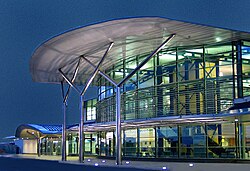Guernsey Airport
| Guernsey Airport | |||||||||||
|---|---|---|---|---|---|---|---|---|---|---|---|
 |
|||||||||||
 |
|||||||||||
| Summary | |||||||||||
| Airport type | Public | ||||||||||
| Operator | States of Guernsey | ||||||||||
| Serves | Guernsey | ||||||||||
| Location | Forest, Guernsey | ||||||||||
| Elevation AMSL | 336 ft / 102 m | ||||||||||
| Coordinates | 49°26′05″N 002°36′07″W / 49.43472°N 2.60194°WCoordinates: 49°26′05″N 002°36′07″W / 49.43472°N 2.60194°W | ||||||||||
| Website | www |
||||||||||
| Map | |||||||||||
| Location in the Channel Islands | |||||||||||
| Runways | |||||||||||
|
|||||||||||
| Statistics (2016) | |||||||||||
|
|||||||||||
| Passengers | 874,818 |
|---|---|
| Passenger change 15–16 |
|
| Aircraft movements | 39,717 |
| Movements change 15–16 |
|
Guernsey Airport (IATA: GCI, ICAO: EGJB) is a minor international airport on the island of Guernsey and also largest airport in the Bailiwick of Guernsey. It is located in the Forest, a parish in Guernsey, 2.5 nautical miles (4.6 km; 2.9 mi) west southwest of St. Peter Port and features mostly flights to the United Kingdom and some European destinations.
The airport was officially opened on 5 May 1939. However, regular air services only commenced in October 1946. By 1948, BEA were operating a daily service to Southampton using Douglas DC-3 aircraft. From 1951, Jersey Airlines flew BEA associate scheduled services to Southampton at weekends using Rapide eight-seat biplane airliners.
In 1960 there were four grass runways, with lengths ranging from 2,040 ft (622 m) to 3,060 ft (933 m). 1960 also saw the construction of a new tarmacked runway of a length of 4,800 ft (1,463 m). In early 2000s alongside the work on the new terminal, the States of Guernsey Commerce and Employment department claimed an extension was necessary to allow use of larger aircraft such as the Boeing 737 Classic or Airbus A320 family for trans-European flights. In 2012, a set of four two-day closures under the Airport 2040 programme allowed contractors for the States of Guernsey to resurface the existing runway, extend runway end safety areas and also reconstruct parts of the concrete apron areas. Taxiways which connect the aprons to the runway were also resurfaced and realigned, whilst a new drainage system was implemented. New airfield ground lighting and navigational aids were also installed.
...
Wikipedia

